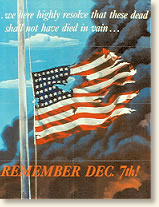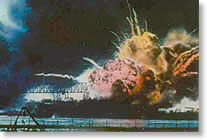|
Attack at Pearl Harbor, 1941
December seventh, 1941: the surprise was complete. The attacking planes came in two waves; the first hit its target at 7:53 AM, the second at 8:55. By 9:55 it was all over. By 1:00 PM the carriers that launched the planes from 274 miles off the coast of Oahu were heading back to Japan.
 |
Poster commemorating
the attack, 1942 |
Behind them they left chaos, 2,403 dead, 188 destroyed planes and a crippled Pacific Fleet that included 8 damaged or destroyed battleships. In one stroke the Japanese action silenced the debate that had divided Americans ever since the German defeat of France left England alone in the fight against the Nazi terror.
Approximately three hours later, Japanese planes began a day-long attack on American facilities in the Philippines. (Because the islands are located across the International Dateline, the local Philippine time was just after 5 AM on December 8.) Farther to the west, the Japanese struck at Hong Kong, Malaysia and Thailand in a coordinated attempt to use surprise in order inflict as much damage as quickly as possible to strategic targets.
Although stunned by the attack at Pearl Harbor, the Pacific Fleet's aircraft carriers, submarines and, most importantly, its fuel oil storage facilities emerged unscathed. These assets formed the foundation for the American response that led to victory at the Battle of Midway the following June and ultimately to the total destruction of the Japanese Empire four years later.
The battleships moored along "Battleship Row" are the primary target of the attack's first wave. Ten minutes after the beginning of the attack a bomb crashes through the Arizona's two armored decks igniting its magazine. The explosion rips the ship's sides open like a tin can starting a fire that engulfs the entire ship. Within minutes she sinks to the bottom taking 1,300 lives with her. The sunken ship remains as a memorial to those who sacrificed their lives during the attack. Marine Corporal E.C. Nightingale was aboard the Arizona that fateful Sunday morning:
"At approximately eight o'clock on the morning of December 7, 1941, I was leaving the breakfast table when the ship's siren for air defense sounded. Having no anti-aircraft battle station, I paid little attention to it. Suddenly I heard an explosion. I ran to the port door leading to the quarterdeck and saw a bomb strike a barge of some sort alongside the NEVADA, or in that vicinity. The marine color guard came in at this point saying we were being attacked. I could distinctly hear machine gun fire. I believe at this point our anti-aircraft battery opened up.
"We stood around awaiting orders of some kind. General Quarters sounded and I started for my battle station in secondary aft. As I passed through casement nine I noted the gun was manned and being trained out. The men seemed extremely calm and collected. I reached the boat deck and our anti-aircraft guns were in full action, firing very rapidly. I was about three quarters of the way to the first platform on the mast when it seemed as though a bomb struck our quarterdeck. I could hear shrapnel or fragments whistling past me. As
 |
A captured Japanese photo shows
Battleship Row under attack.
Hickam Field burns in the distance |
soon as I reached the first platform, I saw Second Lieutenant Simonson lying on his back with blood on his shirt front. I bent over him and taking him by the shoulders asked if there was anything I could do. He was dead, or so nearly so that speech was impossible. Seeing there was nothing I could do for the Lieutenant, I continued to my battle station.
"When I arrived in secondary aft I reported to Major Shapley that Mr. Simonson
had been hit and there was nothing to be done for him. There was a lot of talking
going on and I shouted for silence which came immediately. I had only been there
a short time when a terrible explosion caused the ship to shake violently. I
looked at the boat deck and everything seemed aflame forward of the mainmast.
I reported to the Major that the ship was aflame, which was rather needless,
and after looking about, the Major ordered us to leave.
"I was the last man to leave secondary aft because I looked around and there was no one left. I followed the Major down the port side of the tripod mast. The railings, as we ascended, were very hot and as we reached the boat deck I noted that it was torn up and burned. The bodies of the dead were thick, and badly burned men were heading for the quarterdeck, only to fall apparently dead or badly wounded. The Major and I went between No. 3 and No. 4 turret to the starboard side and found Lieutenant Commander Fuqua ordering the men over the side and assisting the wounded. He seemed exceptionally calm and the Major stopped and they talked for a moment. Charred bodies were everywhere.
"I made my way to the quay and started to remove my shoes when I suddenly found myself in the water. I think the concussion of a bomb threw me in. I started swimming for the pipe line which was about one hundred and fifty feet away. I was about half way when my strength gave out entirely. My clothes and shocked
 |
| The USS Shaw explodes |
condition sapped my strength, and I was about to go under when Major Shapley started to swim by, and seeing my distress, grasped my shirt and told me to hang to his shoulders while he swam in.
"We were perhaps twenty-five feet from the pipe line when the Major's strength gave out and I saw he was floundering, so I loosened my grip on him and told him to make it alone. He stopped and grabbed me by the shirt and refused to let go. I would have drowned but for the Major. We finally reached the beach where a marine directed us to a bomb shelter, where I was given dry clothes and a place to rest."
References:
Lord, Walter, Day of Infamy (1957), Prange, Gordon, At Dawn We Slept (1981), Wallin, VAdm. Homer N. Pearl Harbor: Why, How, Fleet Salvage and Final Appraisal (1968).
How To Cite This Article:
"Attack at Pearl Harbor, 1941," EyeWitness to History, www.eyewitnesstohistory.com
(1997).
|






